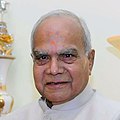# Portrait Name(born – Home state Tenure in office Appointer From To Time in office 1 Muhammad Saleh Akbar Hydari (1894–1948) Hyderabad 4 May 28 December [†] 1 year, 238 days Lord Mountbatten (Governor-General) – Justice Sir Ronald Francis Lodge (1889–1960) – 30 December 15 February 47 days C. Rajagopalachari (Governor-General) 2 Sri Prakasa (1890–1971) Uttar Pradesh 16 February 26 May 1 year, 99 days 3 Jairamdas Daulatram (1891–1979 Maharashtra 27 May 14 May 5 years, 353 days Rajendra Prasad 4 Justice (Retd) Saiyid Fazl Ali (1886–1959) Bihar 15 May 22 August [†] 3 years, 99 days – Justice Chandreswar Prasad Sinha Chief Justice, Assam High Court Bihar 23 August 13 October 51 days 5 General S. M. Shrinagesh (Retd) Maharashtra 14 October 12 November 1 year, 29 days – Vishnu Sahay ICS Uttar Pradesh 12 November 12 February 92 days (5) General S. M. Shrinagesh (Retd) Maharashtra 13 February 7 September 1 year, 206 days 6 Vishnu Sahay ICS (Retd) Uttar Pradesh 8 September [ α] 16 April 5 years, 221 days Sarvepalli Radhakrishnan 7 Braj Kumar Nehru ICS (Retd) Uttar Pradesh 17 April [ β] 7 December 2 years, 234 days Zakir Husain – Justice Parbati Kumar Goswami (1913–1992) Assam 8 December 4 January 27 days V. V. Giri (7) Braj Kumar Nehru ICS (Retd) Uttar Pradesh 5 January [ γ] 18 September 2 years, 256 days 8 Lallan Prasad Singh ICS (Retd) Bihar 19 September [ δ] 11 August 7 years, 326 days 9 Prakash Mehrotra (1925–1988) Uttar Pradesh 12 August [ ε] 28 March [‡] 2 years, 229 days Neelam Sanjiva Reddy – Justice Tribeni Sahai Misra (1922–2005) Uttar Pradesh 28 March [ ε] 15 April 18 days Zail Singh 10 Bhishma Narain Singh (1933–2018) Bihar 15 April [ ε] 11 May 5 years, 26 days 11 Hari Dev Joshi (1920–1995) Rajasthan 10 May [ ε] 21 July [‡] 72 days Ramaswamy Venkataraman – Justice Anisetti Raghuvir (1929–2007) Andhra Pradesh 27 July 1 May 278 days 12 Devi Das Thakur (1929–2007) Jammu and Kashmir 2 May 17 March [‡] 319 days 13 Lokanath Misra (1921–2009) Orissa 17 March 1 September 6 years, 168 days 14 Lieutenant General Srinivas Kumar Sinha (Retd) PVSM ADC (1926–2016) Bihar 1 September 21 April [§] [ ζ] 5 years, 232 days K. R. Narayanan 15 Arvind Dave IPS (Retd) Uttar Pradesh 21 April 5 June 45 days A. P. J. Abdul Kalam 16 Lieutenant General Ajai Singh PVSM AVSM (1934–2023) Rajasthan 5 June 4 July 5 years, 29 days 17 Shiv Charan Mathur (1927–2009) Rajasthan 4 July 25 June [†] 356 days Pratibha Patil 18 Kateekal Sankaranarayanan (1932–2022) Kerala 26 June 26 July [§] [ η] 30 days 19 Syed Sibtey Razi (1939–2022) Uttar Pradesh 27 July 10 December 136 days 20 Janaki Ballabh Patnaik (1927–2015) Odisha 11 December 10 December 4 years, 364 days 21 Padmanabha Balakrishna Acharya (1931–2023) Karnataka 11 December 21 August 1 year, 254 days Pranab Mukherjee 22 Banwarilal Purohit (born 1940) Maharashtra 22 August 9 October [§] [ θ] 1 year, 48 days 23 Jagdish Mukhi (born 1942) National Capital Territory of Delhi 10 October 21 February 5 years, 134 days Ram Nath Kovind 24 Gulab Chand Kataria (born 1944) Rajasthan 22 February 29 July [§] [ ι] 1 year, 158 days Droupadi Murmu 25 Lakshman Prasad Acharya (born 1954) Uttar Pradesh 30 July Incumbent 1 year, 123 days 























